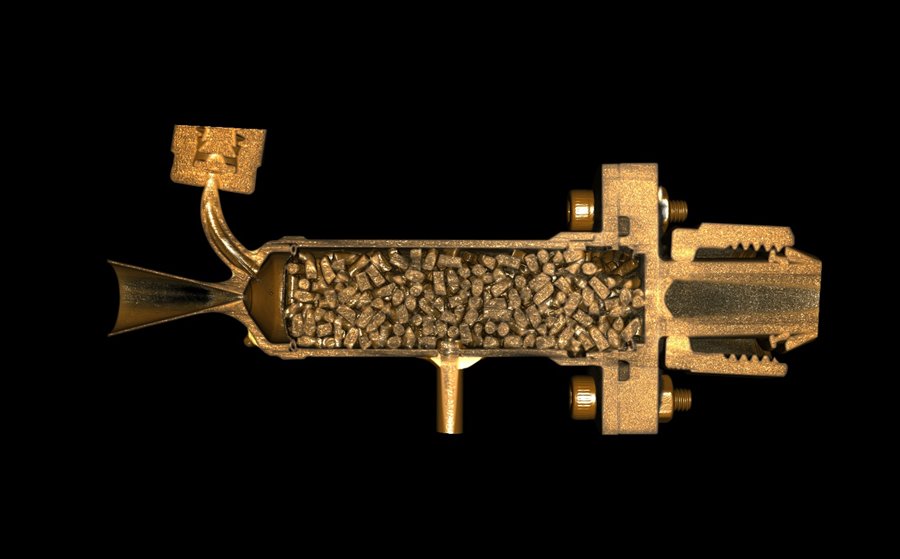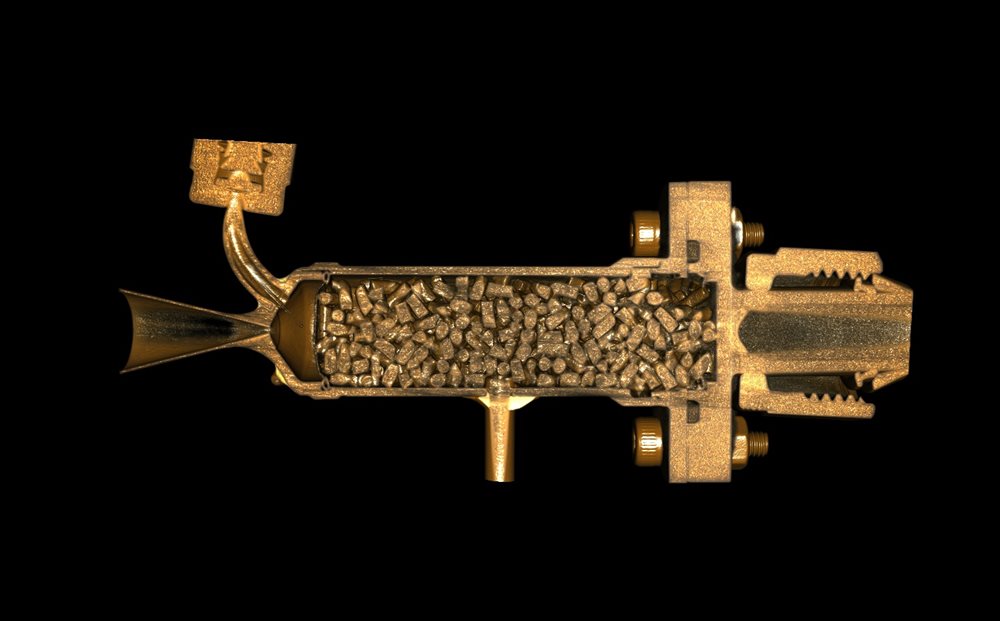
A British consortium led by Surrey Satellite Technology Ltd (SSTL) has been awarded a grant from Innovate UK, the UK’s innovation agency, to co-fund the development of a novel High Test Peroxide (HTP) propulsion system.
The new HTP propulsion system is being designed as an environmentally friendly and cost effective “green” replacement for hydrazine propellant systems, which are currently commonly used in small satellites. Hydrazine is on the REACH* sunset list of chemicals and there is a drive from the space industry to develop alternative high performance, low cost, propulsion systems. SSTL has identified HTP as an environmentally friendly monopropellant with the potential for providing the high performance required for future small satellite missions, and has teamed with partners on a project to bring the new HTP propulsion system design to flight-ready status.
SSTL’s propulsion engineers have designed a prototype HTP propulsion system, and will work together with the consortium partners to resolve the remaining design and materials challenges to achieve a flight-ready concept by the end of 2016. The project will require a comprehensive validation of material compatibility that will be undertaken by European Astrotech (EAL) to demonstrate for future customers the long term suitability of HTP with all system components. A new valve will be developed by SSTL, based on a novel patent from The Open University, and a high-strength Aluminium propellant tank will be developed by TISICS Ltd using fibre reinforced aluminium composite (Al-MMC). Finally the whole system will be built as a ground demonstration unit by SSTL and tested with EAL.
* REACH is the European Regulation on Registration, Evaluation, Authorisation and Restriction of Chemicals. It entered into force in 2007, replacing the former legislative framework for chemicals in the EU.
About SSTL
Surrey Satellite Technology Limited (SSTL) is the world's leading small satellite company, delivering operational space missions for a range of applications including Earth observation, science and communications. The Company designs, manufactures and operates high performance satellites and ground systems for a fraction of the price normally associated with space missions, with 450 staff working on turnkey satellite platforms, space-proven satellite subsystems and optical instruments.
Since 1981, SSTL has built and launched 47 satellites for 20 international customers – as well as providing training and development programmes, consultancy services, and mission studies for ESA, NASA , international governments and commercial customers, with an innovative approach that is changing the economics of space.
Headquartered in Guildford, UK, SSTL is part of the Airbus Group.
www.sstl.co.uk
About Innovate UK
Innovate UK is the UK’s innovation agency. It works with people, companies and partner organisations to find and drive the science and technology innovations that will grow the UK economy.
For further information visit www.innovateuk.gov.uk
About European Astrotech (EAL)
European Astrotech Ltd’s team of experts provide engineering, technical and advisory support to the space propulsion industry for mechanical and chemical services in the supply and test of liquid propellants, material compatibility investigations, equipment design, testing of components and satellite propulsion subsystems, launch and test support, spacecraft propellant loading and pressurisation and other diverse advisory roles in safety and transport issues, design and production of satellite subsystems.
http://www.europeanastrotech.com/
About TISICS Ltd
TISICS develops and manufactures silicon carbide fibre reinforced aluminium and titanium matrix composites. TISICS has a unique capability in Europe to make the silicon carbide fibre and incorporate this in high performance parts for space, aerospace and other demanding environments.
The TISICS team has been working on these light weight metal matrix composite for over 25 years and are developing a number of space use components including pressure vessels with both titanium and aluminium alloys to match propulsion system needs.
www.tisics.co.uk
About The Open University
The Open University (OU) is the largest academic institution in the UK and a world leader in flexible distance learning. Since it began in 1969, the OU has taught more than 1.8 million students and has almost 180,000 current students, including more than 15,000 overseas. In the latest assessment exercise for university research (Research Excellence Framework, 2014), nearly three quarters (72%) of The Open University’s research was assessed as 4 or 3 star – the highest ratings available – and awarded to research that is world-leading or internationally excellent. The Open University is unique among UK universities having both an access mission and demonstrating research excellence.
Space Science at The Open University
Space Science is one of The Open University’s Key Strategic Research Areas. OU research into space contributes to major global challenges through scientific exploitation of imaging and detection technologies and to building the Space sector of the UK economy. The Open University is one of several partners involved in the Rosetta mission, and its team of researchers, alongside those at STFC RAL Space designed and developed Ptolemy – a tool on the spacecraft’s lander Philae. Ptolemy is a gas analysis instrument capable of performing isotopic measurements on individual components from solid and gaseous samples on the comet's surface.
For further information please visit: http://www.open.ac.uk/research/main/our-research/space
Images

Download Hi-Res